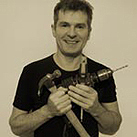 |
 |
Home
Tools
Drilling and Fixing
Putting Things Up
Repairs/Maintenance
Plumbing
Electrics
Woodwork
Decorating a Room
Tiling
Safety & Security
Saving Energy
House and Finance
Health&Safety
Disclaimer
Contact
Advertising
Useful Links
Site Map
| Bulbs | |||||||||||||||||||||||||
There are a huge amount of types and styles of bulbs available these days. The power of the bulb (which will determines how bright it is) will be determined by the wattage which will vary. E.g. for standard light bulbs(230volts 40 watts will be dim), or, (230volts 150 watts will be bright). |
|||||||||||||||||||||||||
Energy saving bulbs use much less power than normal bulbs so save you money and help reduce CO2 emissions. So they are still 230volts but the wattage will be much lower for the same amount of brightness. E.g. a 20watt energy saving bulb is roughly the equivalent of 100watt standard bulb which uses 5 times the power!!! Low energy bulbs are mini fluorescent tube type bulbs. They are currently being superceded by LED bulbs. Most can't be used with a dimmer switch though some LED's can be. Some people don't like the colour of these bulbs |
 |
||||||||||||||||||||||||
There is a huge choice of styles and types or fittings. The fitting will type will have a code. A traditional british standard fitting is bc (=bayonet cap) |
|||||||||||||||||||||||||
| A few common types | |||||||||||||||||||||||||
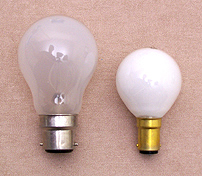 |
|||||||||||||||||||||||||
| Bayonet light bulbs | |||||||||||||||||||||||||
| Bayonet cap (BC) | Small bayonet cap(SBC) | ||||||||||||||||||||||||
 |
|||||||||||||||||||||||||
| Screw in bulbs | |||||||||||||||||||||||||
| Edison Screw(ES) | Small edison screw(SES) | ||||||||||||||||||||||||
 |
|||||||||||||||||||||||||
| Candle bulbs | |||||||||||||||||||||||||
|
BCnnnnnnn SBC |
ES nnnnnn SES | ||||||||||||||||||||||||
| All of the above are available in clear glass or pearl(translucent white) | 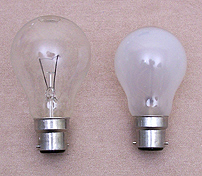 |
||||||||||||||||||||||||
| Fluorescent tubes | |||||||||||||||||||||||||
Come in various lengths and thickness depending on the size of you fitting. The longer the tube the more light it gives and the greater the wattage. These are low energy to. Fluorescent tubes also need a clip in "starter" to make them work. Try replacing this if you've tried the tube(they twist and lock). They are supplied in different ratings to match the tube wattage. |
 |
||||||||||||||||||||||||
 |
|||||||||||||||||||||||||
Halogen capsule bulbs Linear types are often used in exterior security lighting. These come in different lengths and wattages |
 |
||||||||||||||||||||||||
Dichromic bulbs used in down lighters. Come in a variety of wattages and angle of beam (eg from narrow spot light to wide beam). 12volt GU5 push fit pin fitting |
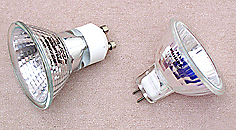 |
||||||||||||||||||||||||
230 volts |
12volts | ||||||||||||||||||||||||
Energy saving bulbs come in several styles. The most common fittings are BC and ES |
|||||||||||||||||||||||||
Checkout http://www.lightbulbs-direct.com which supply a huge range of bulbs at great prices. Their bulb finder section, glossary, and fitting types is very useful. |
|||||||||||||||||||||||||
Tip Test bulbs with a continuity tester. ( NB you can't test fluorescent or low energy bulbs like this) |
|||||||||||||||||||||||||
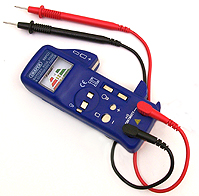 |
|||||||||||||||||||||||||
| Low cost continuity checker. Use it to test fuses and light bulbs Draper BBFC1 approx. £7 |
|||||||||||||||||||||||||
|
|||||||||||||||||||||||||